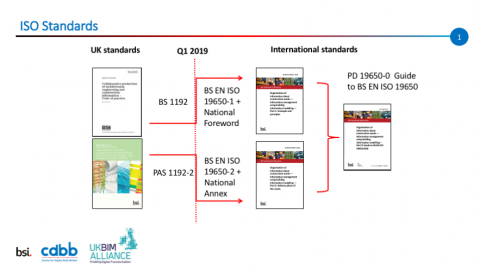
Submitted by Angela Walters on Fri, 10/08/2018 - 14:48
Later this year will see the first two international standards published for Building Information Modelling (BIM) BS EN ISO 19650–1 Organization of information about construction works – Information management using building information modelling – Part 1: Concepts and principles and BS EN ISO 19650-2 Organization of information about construction works – Information management using building information modelling – Part 2: Delivery phase of assets. These two standards will supersede BS 1192 (principles) and PAS 1192 part 2 (capital/delivery phase) respectively.
Concurrent with the delivery of these two new International Organization for Standardization (ISO) standards the British Standards Institution (BSI) will also publish a National Annex to BS EN ISO 19650-2 [to aid implementation in the UK and ensure BIM Level 2 within the ISO framework], National Foreword and a UK Transition Guidance. The National Annex and Foreword are informative texts that provide contextual and supplementary information that does not conflict with the base document.
The National Annex for BS EN ISO 19650-2 is currently available for public comment and the link for commenting is:
Please visit http://standardsdevelopment.bsigroup.com/projects/9018-01874
Note: You will need to login the BSI Standards Development site to access the draft and comment. The deadline for comments is 29th August 2018.
The UK Transition Guidance will take the form of a Published Document (PD), this is a standard-type document however it doesn’t have the same status as a BS, PAS, EN and or ISO standards however it is written in the same form as a British Standard and follows the same rules.
The transition and associated suite of documents is illustrated below:

BS EN ISO 19650-1 and 2 are founded on the UK’s standards for information Management using BIM as per BS 1192:2007+A2:2016 and PAS 1192-2:2013. BS EN ISO 19650 is essentially an internationalisation of the UK’s BIM L2 model and contains all the same principles and high-level requirements with specific UK content contained in our National Annex. ISO documents do however look different, particularly in terminology they use (such as ‘’appointing party’’ instead of employer’’).
Following publication of the ISOs It is not thought there will be any BIM related policy changes. However, the Home Nation Working Group (HNWG) will be working with BSI and the ISO Convenor to understand the need for any changes to their programmes around standards, terminologies, BIM Level 2 templates and the like.
At present all other standards in the BIM Level 2 suite such as PAS1192-3, BS1192-4 and PAS1192-5 will remain extant and part of the new suite, these will be referenced through the UK Annex. In the longer term PAS1192-3 and PAS1192-5 are in the process of transitioning to ISO and will become:
- BS EN ISO 19650-3 Organization of information about construction works Information management using building information modelling – Part 3: Operational phase of assets
- BS EN ISO 19650-5 Organization of information about construction works – Information management using building information modelling – Part 5: Security-minded approach to information management.
The UK’s decision to trigger the move from BIM Level 2 as a UK Standard to international standards is rooted back to 2011 and the ‘Report for the Government Construction Client Group – BIM Strategy Paper.’ The report encouraged the greater adoption of BIM within the UK domestic construction sector and at the same time recognised that BIM would become a disruptive and ‘game changing’ way of working which would have a profound effect on global construction, further, that BIM technologies and processes transcended national or geographic borders. Therefore, during the development of the UK BIM Programme there was growing consensus that BIM-globalisation would inevitably push towards international norms and standards.
Accordingly, the UK, working through its national standard body [BSI], industry and academic organisations and networks, used its existing suite of standards which, by that time, had demonstrated its effectiveness as a tool to aid systematic adoption, as a foundation for collaboration with other nations to develop international standards. The premise of this collaborative approach was that benefits would be realised by all nations, including a common security-minded approach to the adoption of these powerful data/information rich models and tools. Collaterally it was anticipated that such a response would also lay the foundations for a level playing field for international markets and foster trade.
Making a smooth transition to the ISOs are important for UK industry and the journey is being supported by colligate working between the British Standards Institution (BSI), Centre for Digital Built Britain (CDBB) and the UK BIM Alliance as reinforced by the following joint statement:
“We are committed to a co-ordinated approach to creating and communicating an international wrapper for UK BIM and ensuring a smooth transition in the integration of BS EN ISO 19650-1 and 2 within our suite. Collectively we will develop and champion one single set of guidance in a clear and concise manner to support industry understanding and message how to make the shift without confusion.”
